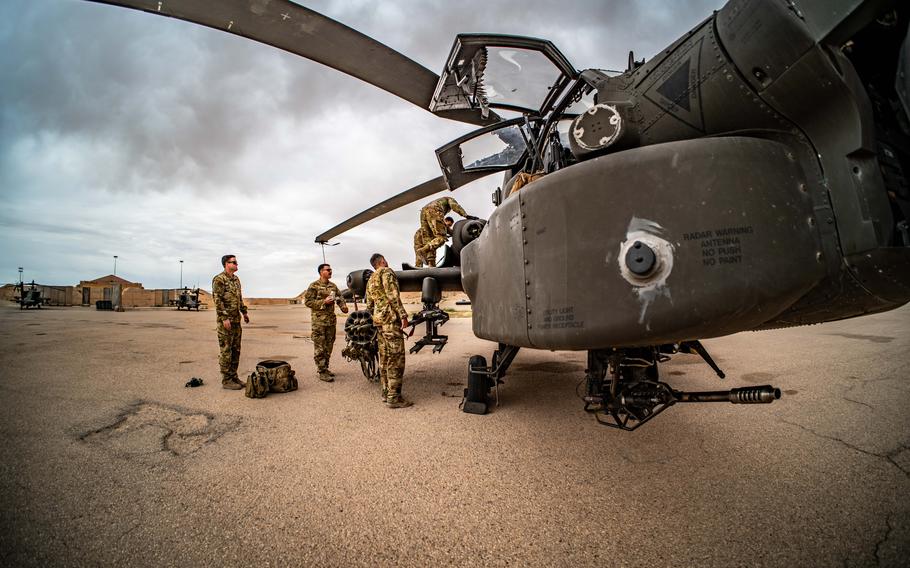
Paratroopers assigned to the 1st Attack Battalion, 82nd Combat Aviation Brigade, 82nd Airborne Division conduct Quick Response Force run-ups on April 10, 2024. (Vincent Levelev/U.S. Army)
The Army on Wednesday directed all its aviation units to conduct new training to curb a sharp uptick in aircraft crashes in recent months, service officials said.
Maj. Gen. Walter Rugen, the Army’s aviation director, dubbed the focused training an aviation “stand up,” as opposed to the typical stand down units do after a series of incidents. The idea is to increase awareness among aviation soldiers to some of the issues surrounding the recent crashes without grounding aircraft or pausing flight activity.
“During this stand up, units will do targeted training that we’ve really been very deliberate about crafting, while continuing to fly missions toward our overarching goal to build enduring [combat] readiness and proficiency in our force,” Rugen told reporters Wednesday just as the order went out to soldiers across the active-duty, National Guard and Reserve forces. “We decided that the recent accident increase would be better mitigated by focusing more on specific training topics to better get at targeted areas that are contributing to many of our safety issues. So, more training is focused training.”
The Army has had 12 Class A mishaps — those in which a person is killed or service equipment sustains at least $2.5 million in damages — in fiscal 2024, which began Oct. 1. It marks a large rise since fiscal 2023, when the service only had nine Class A mishaps for the year. In total, the Army has had about 3.2 Class A mishaps per 100,000 flight hours in fiscal 2024 compared with about 1.1 per 100,000 flight hours in the previous fiscal year, according to service data. Nine U.S. soldiers have died in those crashes, along with one Border Patrol agent.
Rugen said various issues have contributed to the increased crash rate, but he provided few specifics Wednesday, as the service was still investigating about half of the crashes this year.
The training will last roughly four to six hours for aviation soldiers, including pilots, maintainers and flight crew, he said. It will focus on risk management and mitigation for commanders, power management and spatial disorientation for pilots, and broad maintenance topics for maintainers, Rugen said.
He said issues with spatial disorientation — when a pilot struggles to know where the aircraft is in relation to other objects or its altitude — have been a trend in some of the recent incidents, especially “with respect to the ground.”
Much of the training will be new to soldiers, conducted in a classified setting and based on specifics that Army officials have seen in the recent crashes, Rugen said. Other parts of the training will be familiar to soldiers and focus on reinforcing the Army’s aviation standards.
“We’re leaving no stone unturned,” the general said.
Officials from the Army Combat Readiness Center, which is based at Fort Novosel, Ala., and investigates all the service’s Class A mishaps, will travel to all the Army’s aviation units to help guide the training, said Brig. Gen. Jonathan Byrom, the center’s commander.
“We will have our experts working with the very capable trainers at each of these units to have those really graduate [school] level discussions on the mishaps with the focus being to learn from them, so that we don’t repeat any of these problems that we’ve had in the [recent] past,” Byrom said.
The stand up comes just weeks after the National Guard completed an aviation stand down following several crashes involving its helicopters. Rugen said that was part of the reason that the service chose to forgo a traditional stand down for this new approach.
“We want to be empowering to the force,” he said. “Commanders have asked for flexibility, and with the National Guard … just coming out of a stand down, we didn’t want to just keep standing down. We wanted to get some action associated with it to reverse this trend.”
Active-duty aviation units will have until May 10 to complete the stand up training, Rugen said. National Guard and Reserve units will have 60 days to complete it.